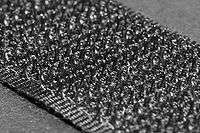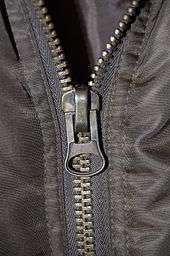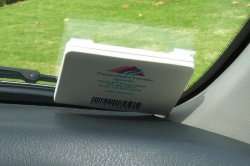Hook and loop fastener




Hook-and-loop fasteners, hook-and-pile fasteners, or touch fasteners consist of two components: typically, two lineal fabric strips (or, alternatively, round "dots" or squares) which are attached (sewn or otherwise adhered) to the opposing surfaces to be fastened. The first component features tiny hooks; the second features even smaller and "hairier" loops. When the two components are pressed together, the hooks catch in the loops and the two pieces fasten or bind temporarily during the time that they are pressed together. When separated, by pulling or peeling the two surfaces apart, the strips make a distinctive "ripping" sound.
Touch fasteners are made in various strengths and constructions by several manufacturers, notably Velcro.
History


The hook-and-loop fastener was conceived in 1941 by Swiss engineer George de Mestral.[1][2][3] The idea came to him one day after returning from a hunting trip with his dog in the Alps. He took a close look at the burrs (seeds) of burdock that kept sticking to his clothes and his dog's fur. He examined them under a microscope, and noted their hundreds of "hooks" that caught on anything with a loop, such as clothing, animal fur, or hair.[4] He saw the possibility of binding two materials reversibly in a simple fashion if he could figure out how to duplicate the hooks and loops.[1][3] Hook and Loop is viewed by some like Steven Vogel[5] or Werner Nachtigall[6] as a key example of inspiration from nature or the copying of nature's mechanisms (called bionics or biomimesis).
Originally people refused to take de Mestral seriously when he took his idea to Lyon, which was then a center of weaving. He did manage to gain the help of one weaver, who made two cotton strips that worked. However, the cotton wore out quickly, so de Mestral turned to synthetic fibers.[4] He settled on nylon as being the best synthetic, which had several advantages: it doesn’t break down, rot, or attract mold, and it could be produced in threads of various thickness.[7] Nylon had only recently been invented, and through trial and error de Mestral eventually discovered that, when sewn under hot infrared light, nylon forms small hook shapes.[1] However, he had yet to figure out a way to mechanize the process, and to make the looped side. Next he found that nylon thread, when woven in loops and heat-treated, retains its shape and is resilient; however, the loops had to be cut in just the right spot so that they could be fastened and unfastened many times. On the verge of giving up, a new idea came to him. He bought a pair of shears and trimmed the tops off the loops, thus creating hooks that would match up perfectly with the loops in the pile.[4]
Mechanizing the process of weaving the hooks took eight years, and it took another year to create the loom that trimmed the loops after weaving them. In all, it took ten years to create a mechanized process that worked.[4]
De Mestral submitted his idea for a patent in Switzerland in 1951, which was granted in 1955.[1] Within a few years he obtained patents and began to open shops in Germany, Switzerland, Great Britain, Sweden, Italy, the Netherlands, Belgium, and Canada. In 1957 he branched out to the textile center of Manchester, New Hampshire in the United States.
Columnist Sylvia Porter made the first mention of the product in her column Your Money's Worth of August 25, 1958, writing, "It is with understandable enthusiasm that I give you today an exclusive report on this news: A 'zipperless zipper' has been invented — finally. The new fastening device is in many ways potentially more revolutionary than was the zipper a quarter century ago."[8]
A Montreal firm, Velek, Ltd., acquired the exclusive right to market the product in North and South America, as well as in Japan, with American Velcro, Inc. of New Hampshire, and Velcro Sales of New York, marketing the "zipperless zipper" in the United States.[9]
De Mestral obtained patents in many countries right after inventing the fasteners, as he expected an immediate high demand. Partly due to its cosmetic appearance, though, hook and loop's integration into the textile industry took time. At the time, the fasteners looked like it had been made from leftover bits of cheap fabric, and thus was not sewn into clothing or used widely when it debuted in the early 1960s.[10] It was also viewed as impractical.[10]

A number of Velcro Corporation products were displayed at a fashion show at the Waldorf-Astoria hotel in New York in 1959,[11] and the fabric got its first break when it was used in the aerospace industry to help astronauts maneuver in and out of bulky space suits. However, this reinforced the view among the populace that Velcro was something with very limited utilitarian uses. The next major use Velcro saw was with skiers, who saw the similarities between their costume and that of the astronauts, and thus saw the advantages of a suit that was easier to don and remove. Scuba and marine gear followed soon after. Having seen astronauts storing food pouches on walls,[12] children's clothing makers came on board.[10] As touch fasteners only became widely used after NASA's adoption of it, NASA is popularly — and incorrectly — credited with its invention.
By the mid-1960s hook and loop fasteners were used in the futuristic creations of fashion designers such as Pierre Cardin, André Courrèges and Paco Rabanne.[13]
Later improvements included strengthening the filament by adding polyester.[7]
In 1978 de Mestral's patent expired, prompting a flood of low-cost imitations from Taiwan, China and South Korea onto the market. Today, the trademark is the subject of more than 300 trademark registrations in over 159 countries. George de Mestral was inducted into the national inventors hall of fame for his invention.[4]
The big breakthrough George de Mestral made was to think about hook-and-eye closures on a greatly reduced scale. Hook and eye fasteners have been common for centuries, but what was new about hook and loop fasteners was the miniaturisation of the hooks and eyes. Shrinking the hooks led to the two other important differences. Firstly, instead of a single-file line of hooks, touch fasteners have a two-dimensional surface.[14] This was needed, because in decreasing the size of the hooks, the strength was also unavoidably lessened, thus requiring more hooks for the same strength. The other difference is that hook and loop has indeterminate match-up between the hooks and eyes. With larger hook and eye fasteners, each hook has its own eye. On a scale as small as that of hook and loop fasteners, matching up each of these hooks with the corresponding eye is impractical, thus leading to the indeterminate matching.[14]
Strength
.jpg)
Various constructions and strengths are available. Some touch fasteners are strong enough that a two-inch square (5 × 5 cm) piece is enough to support a 175-pound (80 kg) load.[7] Fasteners made of Teflon loops, polyester hooks, and glass backing are used in aerospace applications, e.g. on space shuttles. The strength of the bond depends on how well the hooks are embedded in the loops, how much surface area is in contact with the hooks, and the nature of the force pulling it apart. If hook and loop is used to bond two rigid surfaces, such as auto body panels and frame, the bond is particularly strong because any force pulling the pieces apart is spread evenly across all hooks. Also, any force pushing the pieces together is disproportionately applied to engaging more hooks and loops. Vibration can cause rigid pieces to improve their bond. Full-body hook and loop suits have been made that can hold a person to a suitably covered wall.
When one or both of the pieces is flexible, e.g. a pocket flap, the pieces can be pulled apart with a peeling action that applies the force to relatively few hooks at a time. If a flexible piece is pulled in a direction parallel to the plane of the surface, then the force is spread evenly, as it is with rigid pieces.
Three ways to maximize the strength of a bond between the two flexible pieces are:
- increase the area of the bond, e.g. using larger pieces.
- ensure that the force is applied parallel to the plane of the fastener surface, such as bending around a corner or pulley.
- increase the number of hooks and loops per area unit.
Shoe closures can resist a large force with only a small amount of hook and loop fasteners. This is because the strap is wrapped through a slot, halving the force on the bond by acting as a pulley system (thus gaining a mechanical advantage), and further absorbing some of the force in friction around the tight bend. This layout also ensures that the force is parallel to the strips.
Advantages and disadvantages

Touch fasteners are easy to use, safe, and maintenance free. There is only a minimal decline in effectiveness even after many fastening and unfastenings. The tearing noise it makes can also be useful against pickpockets.
There are also some deficiencies: it tends to accumulate hair, dust, and fur in its hooks after a few months of regular use. The loops can become elongated or broken after extended use. The hooks often become attached to articles of clothing, especially loosely woven items like sweaters. This clothing may be damaged when one attempts to remove the Velcro, even if the sides are separated slowly. The tearing noise made by unfastening hook and loop fasteners make it inappropriate for some applications. For example, a soldier in hiding would not want to alert the enemy to his position by opening a pocket.[1] It also absorbs moisture and perspiration when worn next to the skin, which means it will smell if not washed.
Textiles can contain chemicals or compounds, such as dyes,[15] that may be allergenic to sensitive people. Some products have been tested according to the Oeko-tex certification standard, which imposes limits on the chemical content of textiles to address the issue of human ecological safety.
Applications
Because its ease of use, hook-and-loop fasteners have been used for a wide variety of applications where a temporary bond is required. It is especially popular in clothing where it replaces buttons or zippers, and as a shoe fastener for children who have not yet learned to tie shoelaces. Touch fasteners are used in adaptive clothing, which is designed for people with physical disabilities, the elderly, and the infirm, who may experience difficulty dressing themselves due to an inability to manipulate closures such as buttons and zippers.
Touch fasteners held together a human heart during the first artificial heart surgery, and it is used in nuclear power plants and army tanks to hold flashlights to walls. Cars use it to bond headliners, floor mats and speaker covers. It is used in the home when pleating draperies, holding carpets in place and attaching upholstery.[4] It closes backpacks, briefcases and notebooks, secures pockets, and holds disposable diapers, and diaper covers for cloth diapers, on babies. It is an integral part of the game tag rugby, and is used in surfboard leashes and orthopaedic braces.
NASA makes significant use of touch fasteners. Each space shuttle flew equipped with ten thousand inches of a special fastener made of Teflon loops, polyester hooks, and glass backing.[7] Touch fasteners are widely used, from the astronauts' suits, to anchoring equipment. In the near weightless conditions in orbit, hook and loop fasteners are used to temporarily hold objects and keep them from floating away.[16] A patch is used inside astronauts' helmets where it serves as a nose scratcher.[4][7] During mealtimes astronauts use trays that attach to their thighs using springs and fasteners.[12]
The US Army uses hook and loop fasteners on combat uniforms to attach name tapes, rank insignia, shoulder pockets for unit patches, skill tabs, and recognition devices, such as the infrared feedback American flag.
Variations on touch fasteners
The Slidingly Engaging Fastener was developed to address several problems with common hook and loop fasteners.[17][18] Heavy-duty variants (such as "Dual Lock" or "Duotec") feature mushroom-shaped stems on each face of the fastener, providing an audible snap when the two faces mate. A strong pressure sensitive adhesive bonds each component to its substrate.
There is a silent version of touch fasteners, sometimes called Quiet Closures.
Standards
- ASTM D5169-98 (2010) Standard Test Method for Shear Strength (Dynamic Method) of Hook and Loop Touch Fasteners
- ASTM D5170-98 (2010) Standard Test Method for Peel Strength (“T” Method) of Hook and Loop Touch Fasteners
- ASTM D2050-11 Standard Terminology Relating to Fasteners and Closures Used with Textiles
In popular culture
In the fictional universe of Star Trek, Velcro was invented by the Vulcans. In the Star Trek: Enterprise episode "Carbon Creek", a sample touch fastener is taken from a crashed Vulcan starship by T'Mir and given to a patent clerk to raise money for a teenage boy's college career. Also, one of the Vulcan crew members in that episode is named Mestral.
Velcro gained popularity in many new styles of use when a 1984 interview between David Letterman and the Velcro Corporation’s USA director of industrial sales ended with Letterman jumping off a trampoline onto a wall while wearing a Velcro suit.[19]
In 1992, Velcro was mentioned in the sitcom Seinfeld, episode "The Wallet", where Jerry's father, Morty Seinfeld, states that he hates Velcro, due to the distinctive sound it makes when the two sides are being separated: "The Velcro! I can't stand Velcro! That tearing sound!"
References
- 1 2 3 4 5 Stephens, Thomas (2007-01-04). "How a Swiss invention hooked the world". swissinfo.ch. Retrieved 2008-05-09.
- ↑ McSweeney, Thomas J.; Stephanie Raha (August 1999). Better to Light One Candle: The Christophers' Three Minutes a Day: Millennial Edition. Continuum International Publishing Group. p. 55. ISBN 978-0-8264-1162-4. Retrieved 2008-05-09.
- 1 2 "About us: History". Velcro.us. Retrieved 2013-11-13.
- 1 2 3 4 5 6 7 Strauss, Steven D. (December 2001). The Big Idea: How Business Innovators Get Great Ideas to Market. Kaplan Business. pp. 15–pp.18. ISBN 978-0-7931-4837-0. Retrieved 2008-05-09.
- ↑ Steven Vogel (1988). Life's Devices: The Physical World of Animals and Plants. ISBN 978-0-691-02418-9.
- ↑ Nachtigall, W. 1974. Biological Mechanisms of Attachment: the comparative morphology and bionengineering of organs for linkage New York : Springer-Verlag
- 1 2 3 4 5 Schwarcz, Joseph A. (October 2003). Dr. Joe & What You Didn't Know: 99 Fascinating Questions About the Chemistry of Everyday Life. Ecw Press. p. 178. ISBN 978-1-55022-577-8. Retrieved 2008-05-09.
But not every Velcro application has worked ... A strap-on device for impotent men also flopped.
- ↑ Sylvia Porter, "Your Money's Worth", Syracuse Herald-Journal, August 25, 1957, p21
- ↑ Id.
- 1 2 3 Freeman, Allyn; Bob Golden (September 1997). Why Didn't I Think of That: Bizarre Origins of Ingenious Inventions We Couldn't Live Without. Wiley. pp. 99–pp.104. ISBN 978-0-471-16511-8. Retrieved 2008-05-09.
- ↑ Suddath, Claire (June 15, 2010) A Brief History of: Velcro, Time.com
- 1 2 Jones, Thomas; Benson, Michael (January 2002). The Complete Idiot's Guide to NASA. Alpha. pp. 130–132. ISBN 978-0-02-864282-6. Retrieved 2008-05-09.
- ↑ Jane Pavitt (2008-09-01). Fear and fashion in the Cold War. Victoria & Albert Museum. ISBN 978-1-85177-544-6.
- 1 2 Weber, Robert John (February 1993). Forks, Phonographs, and Hot Air Balloons: A Field Guide to Inventive Thinking. Oxford University Press. pp. 157–160. ISBN 978-0-19-506402-5. Retrieved 2008-05-09.
- ↑ Crespo et al, Contact Dermatitis, 2009
- ↑ Jones, Thomas; Michael Benson (January 2002). The Complete Idiot's Guide to NASA. Alpha. p. 18. ISBN 978-0-02-864282-6. Retrieved 2008-05-09.
- ↑ Mone, Gregory (2007-05-14). "Invention awards The New Velcro". Popular Science. Archived from the original on 2010-01-17. Retrieved 2008-05-10.
- ↑ Body Beauty (2007-06-11). "Velcro Reinvented". InventorSpot.com. Archived from the original on 2010-01-17. Retrieved 2008-05-10.
- ↑ Goodrick, Ryan. "Who Invented Velcro?". livescience. Retrieved 2015-04-30.